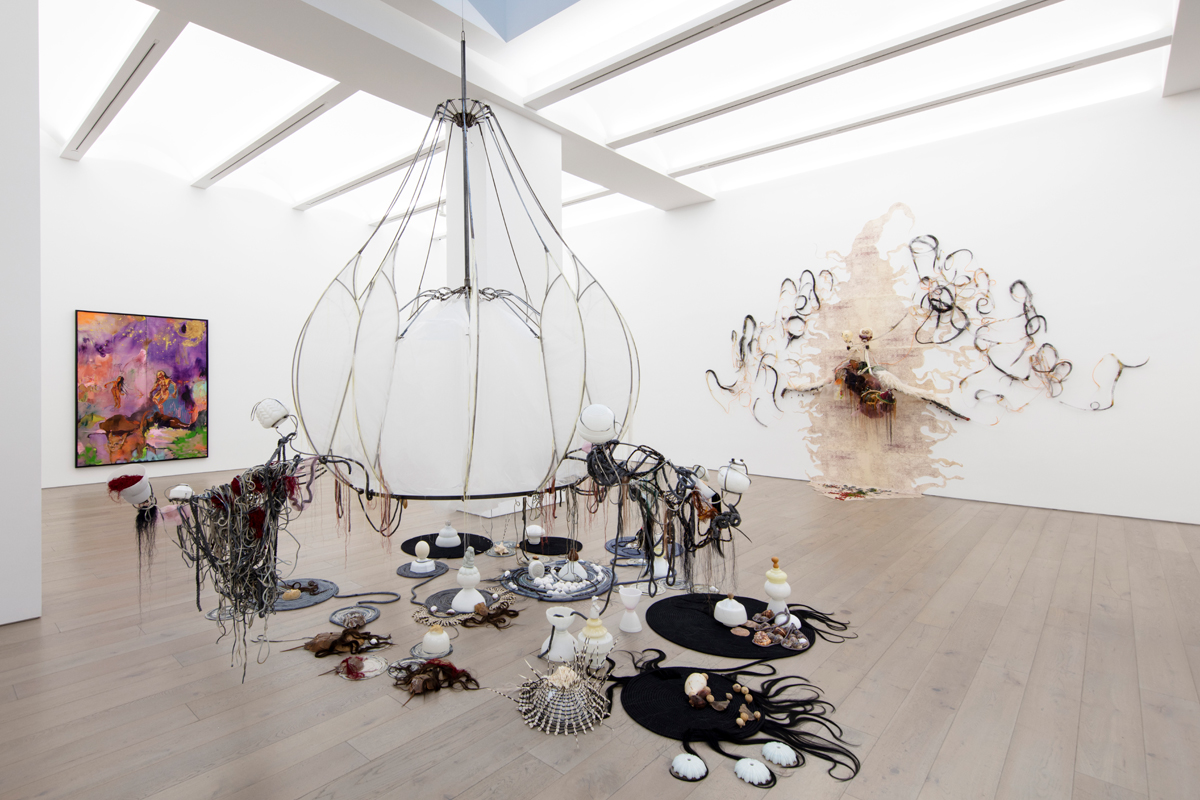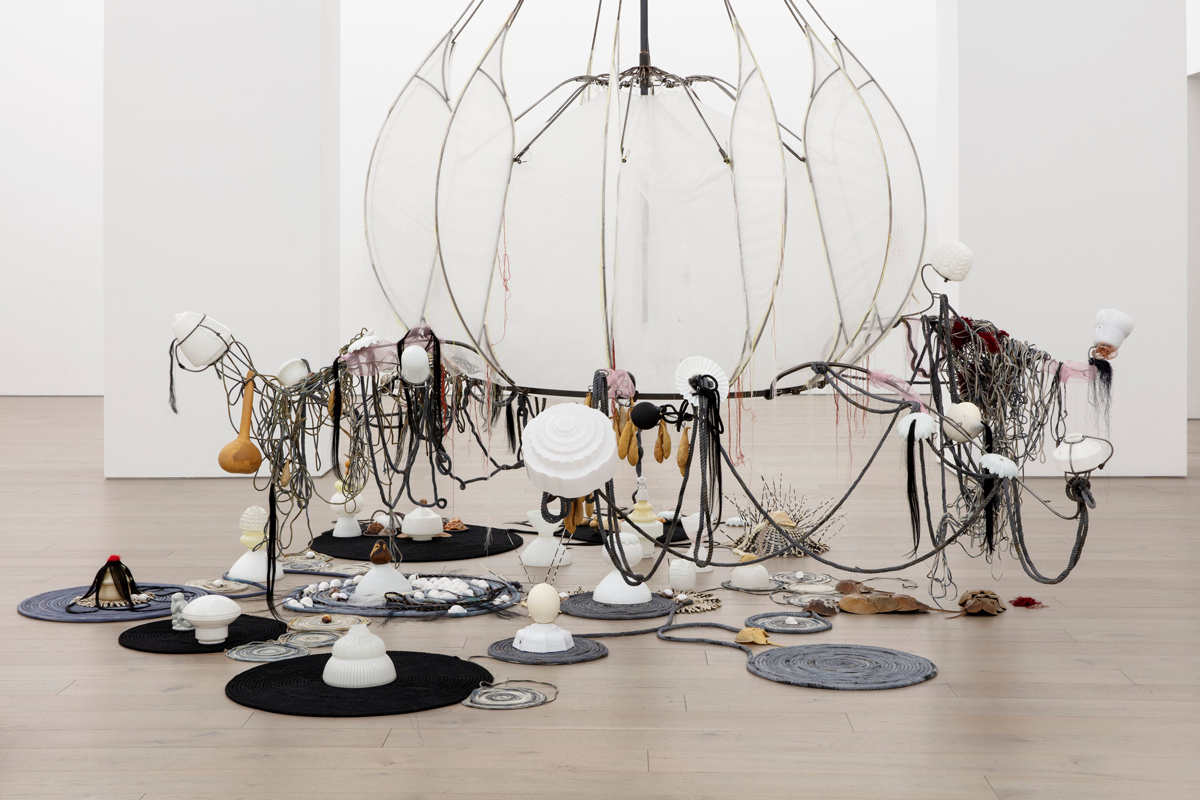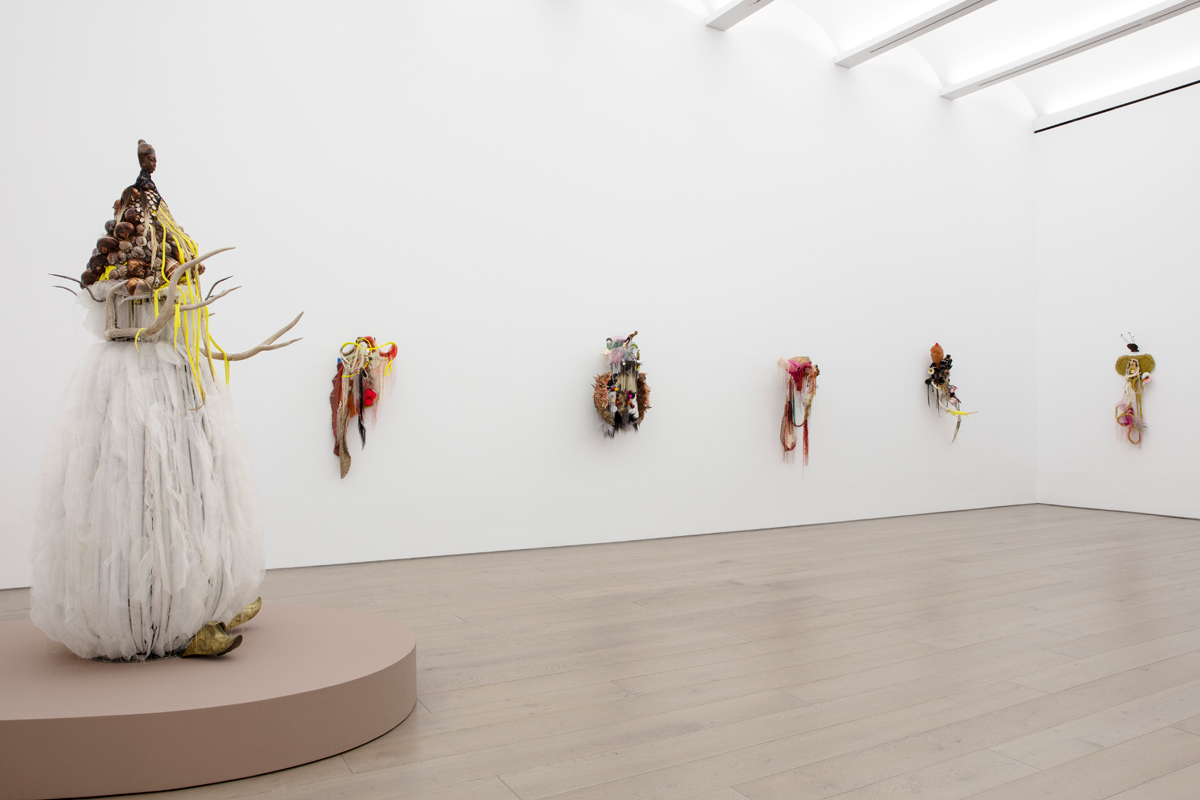 Aruna D’Souza
Aruna D’Souza
Hair, trade, exploration, noodles: the complexities of diasporic movement in twenty-nine works.

Rina Banerjee: Black Noodles, installation view. Courtesy the artist and Perrotin. Photo: Guillaume Ziccarelli. Pictured, center foreground: Black Noodles, 2023. Back right wall: Contagious Migrations, 1999–2023.
Rina Banerjee: Black Noodles, Perrotin, 130 Orchard Street, New York City, through June 10, 2023
• • •
The concurrence of a group of exhibitions in New York City this spring has been a gift: Wangechi Mutu’s retrospective at the New Museum, Sarah Sze’s installations at the Guggenheim, Shahzia Sikander’s public-art project at Madison Square Park, and, though perhaps with less fanfare, Rina Banerjee’s debut at Perrotin. All four women came to prominence in the 1990s, when “globalism” was the curatorial word of the day and art fairs were proliferating around the world, and all built their practices on approaches to assemblage and collage that crossed borders and histories. They are diasporic bricoleurs whose art is not about cultural origins or destinations so much as the idea of movement itself.

Rina Banerjee, Contagious Migrations, 1999–2023 (detail). Incense sticks, kumkum, vaseline, turmeric, Indian blouse gauze, fake fingernails and eyelashes, chalk, foam, feathers, fabric, Spanish moss, light bulbs, wax, Silly Putty, quilting pins, plastic tubing, latex and rubber gloves, acrylic and dry pigment. Courtesy the artist and Perrotin. Photo: Guillaume Ziccarelli.
Banerjee is currently showing twenty-nine works at Perrotin, spread over two floors, ranging from wall-mounted and freestanding sculptures to works on paper to paintings, most from the past three years. Among them is a reconstruction of a piece from her 1999 series An Uncertain Bondage Is Deserved When Threatening Transmission—one that weaves together many of the themes underpinning her practice. Contagious Migrations (1999–2023) is an accumulation of disparate objects and materials: incense sticks and kumkum (the red powder with many ritual uses that Hindu women apply as a bindi or to mark the part in their hair); fake fingernails and eyelashes; foam, feathers, fabric, and Spanish moss; plastic tubing, latex and rubber gloves. Some are found, but they are just as often purchased from vendors both close to home and very distant—her work is predicated on our global, one-click-away marketplace. The bits and bobs are arrayed on a large, vaguely symmetrical, blobby, cut-out blueprint that runs down the wall and extends onto the floor—a schematic diagram of the air ducts and electrical systems at the Columbia Center for Disease Control that the artist came across over twenty years ago, and has been using in her work since, often (as here) in the form of a scanned reproduction. Plastic medical tubing, sometimes yellow as urine, sometimes wrapped in black netting, snakes out irregularly from the edges of the paper, while a constellation of stuff at its center is adorned with embroidered textiles, feathery fringes, cowrie shells, and sundry beads and baubles.
The allusions are myriad: molecules, the spread of gaseous vapors, viscera, Victorian natural-history museums, an anemone- or squid-like sea creature, Medusa with her snakelike hair and lethal gaze, the tangle of life support (or death support) visible from the hospital beds of doomed souls. When Banerjee first made the piece in 1999, she was thinking of the AIDS crisis—specifically, the way it was spreading in Africa and Asia—and, more generally, of how the language of contagion is wielded in the Global North against immigrants, who are seen both as vectors of disease and as disease per se, a potential source of rot in the social body. Though the trope of the Other as virus is as old as modernity itself, in the wake of the Covid crisis—with all its anti-Asian, xenophobic ugliness—it feels frustratingly contemporary, too.

Rina Banerjee, Shareena, she chose, lost all her noodles to western explorer, 2023. Watercolor paper, ink, dye, acrylic, coffee, sodium bicarbonate, varnish, 20 × 16 inches. Courtesy the artist and Perrotin. Photo: Guillaume Ziccarelli.
The exhibition is called Black Noodles, which strikes me as hilarious—“noodles” is an objectively funny word to roll around your mouth. Banerjee has always paid particular attention to her titles, coercing the English language to take on the expressive needs of its billions of speakers—speakers who have often had the tongue forced on them through the exigencies of colonialism and economic imperialism, but stubbornly refuse to let it trap them. Many of these titles, which appear in a handsome booklet produced by the gallery for the occasion, are exceedingly long—and noodles are everywhere to be found. A 2023 drawing depicting a woman-headed beast crowned by lush, curly locks is called: Shareena, she chose, lost all her noodles to western explorer eating mighty eating beauty in traded with the other, traded people like poodles. Hair is a topical currency, like cream applied once could change desire even urgency. Caught in the air like flyaway hair in parts like runaway stares and easter egg hunts washed head in color and red ribbons fooled no one cause she done up in her own nature not her explorers surrender. What trips off the tongue like a silly nursery rhyme appears, on further reflection, to recount horrors: colonial explorers, rapacious consumption, enslavement, the West’s simultaneous hunger for and will to destroy the Other, the colonial subject’s desire for her oppressor.

Rina Banerjee, Black Noodles, 2023 (detail). Forged steel, vintage milk glass, hand-dyed rope, shells, gourds, polyethylene netting, porcupine quill, silk thread, synthetic and human hair, horseshoe crab, polyurethane, ostrich egg, and glass. Courtesy the artist and Perrotin. Photo: Guillaume Ziccarelli.
Black Noodles’ centerpiece is the eponymous sculpture that hangs from the center of the main-floor gallery: a forged-steel armature with curved arms sprouting vintage milk-glass lampshades and shrouded with dangling, coiling vines made of rope, silk thread, and synthetic and human hair. On the floor, more swirls of fiber—black and noodle-y, some tightly arranged into circular mats as landing pads for milk glass, shells, gourds, and ostrich eggs, occasionally festooned with porcupine quills. The effect is that of a chandelier from an underwater palace, or maybe a jellyfish in locomotion. But as aquatic as it may appear, it’s also definitively mammalian in its hairiness—the fibrous strands draped over the metal frame clump like knotted wigs, while some of the glass orbs are affixed with perfect ponytails; hairs frizz wildly from the coiled mats, and other times are arranged in soft, beautiful waves upon them. Here hair is indeed a topical currency: Indian women’s tresses, shorn out of religious devotion or economic need, are a multi-million-dollar industry, sold to wigmakers around the world, and especially prized by Black women who have been told over centuries of white supremacy that their own hair is not beautiful enough. This is a commodity made desirable because of racism, in other words, and it quite suitably becomes something mildly repellent in Banerjee’s hands, like seaweed wrapping around your leg as you swim.

Rina Banerjee: Black Noodles, installation view. Courtesy the artist and Perrotin. Photo: Guillaume Ziccarelli.
Banerjee has had a robust presence in Europe, and a major traveling retrospective opened at the Pennsylvania Academy of Fine Arts in 2018—but, despite her inclusion in major group shows in New York, this is her first significant solo outing in the city she came to at age seven after a circuitous journey from her birthplace of Calcutta. Such belated attention may be a product of the fact that she is a South Asian American artist—a category surprisingly underrepresented in New York galleries and museums, even though people from the subcontinent now make up the second-largest Asian immigrant group in the US. In interviews, she has balked at the way her country of origin has been used as a one-size-fits-all interpretive lens for her practice, and rightly so: if Banerjee traffics at all in ideas around identity, she does so to upend any easy understanding of the concept. Her art mines materials tracing back to South Asia—but she braids them together with elements from many other places, from east and west to north and south, past and present. In doing so, Banerjee makes clear that identity, for the diasporic subject, is not rooted in a singular place, but rather accretes over time and space.
Aruna D’Souza is the 2022–23 W. W. Corcoran Professor of Social Engagement at the Corcoran School of Art and Design in Washington, DC and a contributor to the New York Times and 4Columns. She was awarded the Rabkin Prize for arts journalism in 2021.